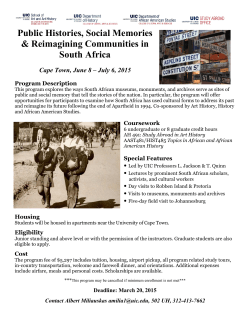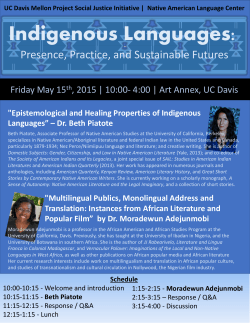
File
Name Class CHAPTER 20 The Civil Rights Struggle Date READING ESSENTIALS AND STUDY GUIDE Section 1: Challenging Segregation For use with textbook pages 668–672 Key Terms segregation Separation of blacks and whites in schools, housing, and other places (page 668) civil rights The political, economic, and social rights of all citizens (page 669) DRAWING FROM EXPERIENCE Name some famous players in professional sports. Are some of them African American? Until 1947 African Americans were not allowed on white professional teams. Then Jackie Robinson became the first African American in baseball’s white major leagues. Others soon followed. This section describes the fight over separation of the races in the United States. ORGANIZING YOUR THOUGHTS Use the diagram below to help you take notes. List actions and Supreme Court decisions for integration, or including, of the races. Also list actions and decisions that resisted integration. ACTIONS RESISTING INTEGRATION Copyright ©The McGra w-Hill Companies, Inc. ACTIONS FOR INTEGRATION AMERICAN ODYSSEY: Chapter 20 215 Name Class CHAPTER 20 Date READING ESSENTIALS AND STUDY GUIDE Section 1: Challenging Segregation Continued READ TO LEARN Introduction (page 668) Laws in the South separated blacks and whites. This was segregation. It was part of the culture of the South. African Americans had to sit in the back of buses. They had to eat in different restaurants and go to different schools than whites. Often, they could not vote. Segregation was not the law in the North. Yet the split still happened. For example, whites moved outside of cities as African Americans moved in. School districts were drawn to include only black or only white neighborhoods. The separation began to change in 1947. Jackie Robinson became the first black athlete in baseball’s white major leagues. He held his temper and put up with angry teammates and fans. His talent in baseball won over many people. Soon other African Americans began entering the white leagues. 1. How did segregation happen in the North? The Segregation System (page 669) School segregation was an important issue. Attitudes children learn in school might stay with them the rest of their lives. Only 16 states required schools to include all races. Schools in these states often did not obey. In 1950 the Supreme Court made three decisions in one day. The decisions helped those fighting for civil rights, the rights of all citizens. First, the Court ruled that railroad dining cars had to give the same service to all travelers. Second, African American students could not be kept apart from white students in the same school. Third, more than just buildings and books had to be considered when comparing the education given to African Americans and whites. The Challenge of the Courts (page 669) The 1896 Supreme Court case Plessy v. Ferguson set the “separate but equal” rule. In that case, the Court ruled that if African Americans and whites were given equal seats on trains, it was okay to separate the races. Soon this “separate but equal” rule was being applied to housing, restaurants, swimming pools, and other public places. The National Association for the Advancement of Colored People (NAACP) chipped away at the rule. It brought case after case to the Supreme Court. In each case, the Court ruled that the separate facilities were not, in fact, equal. Charles Houston led the fight for the NAACP. He was a Harvard Law School graduate. He later taught at all-black Howard University. His assistant was Thurgood Marshall. Marshall took over the fight when Houston died in 1950. Marshall later became the first African American judge on the Supreme Court. 216 AMERICAN ODYSSEY: Chapter 20 Copyright ©The McGra w-Hill Companies, Inc. 2. Why was school segregation an important issue? Name Class CHAPTER 20 Date READING ESSENTIALS AND STUDY GUIDE Section 1: Challenging Segregation Continued The NAACP was succeeding in proving that separate was not equal. In 1950, though, they decided to fight segregation head-on. They would try to prove that segregation itself was not legal. Brown v. the Board of Education of Topeka, Kansas was the case that helped end school segregation. In Topeka, the schools were fairly alike in quality. Yet seven-year-old Linda Brown had to cross a dangerous railroad yard to catch a bus to her all-black school. Her father wanted her to go instead to the all-white school a few blocks away. Chief Justice Earl Warren delivered the Court’s ruling in 1954. He said that separating children by race denied minority children an equal education. It did not matter that the school buildings were of equal quality. 3. What did the case Plessy v. Ferguson do? Resistance to Brown (page 671) The Court ruling made school segregation illegal. Yet it did not say how to integrate. Many Southern schools tried to find ways to avoid the law. White parents would not allow their children to attend integrated schools. Southern state governments passed laws against integration. For example, Virginia passed a law to cut off money to integrated schools in the state. In 1956, 100 Southern members of Congress signed a paper praising state governments that resisted integration. One member who would not sign was Lyndon B. Johnson of Texas. Eisenhower tried to stay neutral on integration. He wanted the states to fix the problem. 4. How did Southern state governments resist integration? Copyright ©The McGra w-Hill Companies, Inc. Crisis at Little Rock (page 671) The school board in Little Rock, Arkansas, made plans to bring 9 African American students into the all-white Central High School. Just before school began in 1957, Arkansas governor Orval Faubus ordered the state National Guard to circle the school. He said he did it to avoid trouble. Faubus asked Eisenhower for a year’s delay on desegregation. Eisenhower said no. In response, Faubus removed the state troops. As a result, an angry mob of whites gathered at the school. The African American students had to leave under police protection. Eisenhower had to take action. He ordered national troops into Little Rock. The soldiers brought the students to school. They protected the students for the rest of the year. The next year, the Little Rock public schools closed. White students were able to attend private schools or schools outside the city. African American students had no schools. Finally, in 1959 the Supreme Court required the Little Rock schools to integrate and open again. 5. How did closing the Little Rock schools avoid desegregation? AMERICAN ODYSSEY: Chapter 20 217
© Copyright 2025












